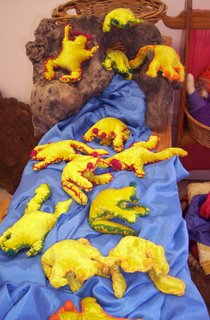
Class: Kindergarten
Subject: Craft/Sewing
Object: Frog
The frog character was first introduced in a curative nature-based story. Through this story the children learnt of the development of tadpole to frog and about the frogs living environment. I was able to weave a curative aspect into the storyline to help some behavioural issues the class have been dealing with.
The children were given a (fabric) frog that had been sewn together with a hole for the filling to go into. They filled the frog with rice – manipulating the rice into the all the legs and the head, and then were able to sew up the hole and along the seam of the entire frog decoratively.
The children were taught blanket stitch for this lesson and were also required to felt balls for the eyes and sew them on.
The result: the children have a very beautiful toy to play with and to snuggle at rest-time.

Viewing this lesson in a constructivist learning environment I have highlighted the key learning features.
Active – I introduced blanket stitch to the children by doing 2 stitches in front of them and each child would do one stitch in front of me, then leave them to continue. As this was the first time most of the students had done blanket stitch I was aware this wasn’t enough guidance but I wanted to allow them to discover how to do it with only just enough guidance from me.
Constructive – This lesson built on already learned skills. Our first sewing a cardboard art folder, using beeswax on the end of the wool as a “needle”, sewing through already punched holes. We moved onto a simple running stitch with a real needle, then onto our decorative blanket stitch.
Collaborative – Having left the hole for filling the frog between the back legs it was quite difficult to manipulate the rice filling into the hind legs. A couple of children discovered how to do it and when a child expressed their difficulties these children in their naturally helpful way would show them how to do it – leaving me free to solve the “bigger problems”.
Intentional – The children’s goal was to learn blanket stitch and to create their own beautiful toy.
Complex – During the story for this lesson the children were taken on an adventure with the “croaker loaker chorus”, as I was dealing with behavioural issues in this story one frog had been “led astray”. The children are very involved during story-time and can’t help but call out “solutions” to the problem – which I then incorporate into the story.

Contextual – This story “happened” at “crystal creek”, when the class were taken on a bushwalk they “discovered” crystal creek. Much excitement ensued as we looked for (and found) the characters from our stories.
Conversational – The children are divided into 5 work tables where they are able to chat and help each other as they work, sometimes travelling to other tables to help them.
Reflective – The children are so proud of their beautiful frogs – I love to see them showing their parents their work and hear them explain how they did it (often in great detail). I have reports back from parents that they have been taught blanket stitch at home by their children.

0 Comments:
Post a Comment
<< Home